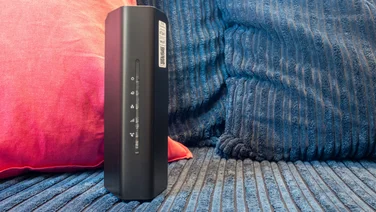To help us provide you with free impartial advice, we may earn a commission if you buy through links on our site. Learn more














- Able to reach Wi-Fi “not-spots”
- Respectable parental controls
- Works with other Deco units
- Slower than most Wi-Fi only systems
- Basic software features
- Not enough Ethernet ports
There’s a considerable number of different mesh networking systems out there from various manufacturers but they all work in the same basic way, using a wireless “backhaul” connection to yoke multiple access points together.
The Deco P9 does things a bit differently. Its three nodes can communicate wirelessly, but they also make use of powerline networking to provide additional backhaul bandwidth and potentially extend coverage to areas where a normal mesh platform couldn’t reach.
It’s great to see a bit of fresh thinking in this market. The question is, does it actually work, or are you better off with a conventional mesh product?
READ NEXT: Best mesh Wi-Fi – the best way to extend your home’s wireless network
TP-Link Deco P9 review: What you need to know
The TP-Link Deco P9 is an 802.11ac wireless mesh network system, which can either replace your router or operate in access point mode to extend an existing router’s wireless network.
Its Wi-Fi provision is fairly modest: there’s no support for next-generation 802.11ax connections (also known as Wi-Fi 6), and its 802.11ac capabilities are unambitious by modern standards, with rated speeds of 300Mbits/sec on the 2.4GHz band and 867Mbits/sec over 5GHz. Each unit contains only two antennae, enough for 2×2 MU-MIMO, and there’s no separate radio dedicated to backhaul traffic.
What makes the P9 special is that each station also has a built-in powerline networking adapter, which provides extra bandwidth for relaying traffic back and forth between nodes. Officially, the powerline components use the HomePlug AV2 standard and are rated at 1,000Mbits/sec but, in practice, that’s somewhat academic, as they don’t interoperate with other HomePlug devices and, if you’ve ever used powerline networking, you’ll know that the rated speeds bear zero relation to real-world performance.
TP-Link Deco P9 review: Price and competition
The Deco P9 costs £170 for a three-node kit with a claimed coverage of 560m2. That’s quite affordable, but there are plenty of competing mesh systems in the same price bracket. In particular, we’re fans of the BT Whole Home Wi-Fi, which is slightly cheaper at £164 for three units – or you might compare the tri-band Zyxel Multy U, now available in a three-node pack for a very reasonable £179. Even cheaper options are the Tenda Nova MW6, at just £130, or the bare-bones TP-Link Deco E4, costing a mere £90 for a three-piece set.
For those willing to pay more for improved performance and features, we’re also enamoured of the £250 Zyxel Multy X – which comes with two units promising coverage up to 420m2 – and the Netgear Orbi RBK50, costing £260 for a two-node pack offering coverage of 460m2.
All of these are pure Wi-Fi mesh systems, however. If what you’re chiefly interested in is the combination of mesh and powerline networking, the Deco P9 is the only game in town.
TP-Link Deco P9 review: Design and features
The Deco P9 units are three identical white cylinders with a stylised pattern set into their tops. They stand 190mm tall, with a rounded rectangular footprint of 91x91mm. They look a bit like Amazon Echo devices, although they don’t have built-in microphones or speakers.
They also don’t have a display, aside from a single-colour LED recessed into the top. This isn’t ideal, since it means you may not be able to see when one’s glowing red for an error condition without walking up and standing over it, although that issue didn’t arise during our testing.
Another disappointing design choice is the presence of a mere two Gigabit Ethernet ports on each node. On your router unit, one of these will be connected to your modem, leaving you just one wired socket and, if you want to take advantage of the Deco P9’s Ethernet backhaul option, the main unit won’t have any spare ports at all.














Getting set up proved quick and easy, although there’s no web portal so everything has to be done via the TP-Link Deco smartphone app. Administrative options include turning the guest network on and off, blacklisting specific clients, reserving IP addresses for specific devices and setting up port forwarding. There’s no VPN support, though, and traffic management options aren’t exactly extensive: you can designate up to 16 devices as high-priority, but you can’t set specific usage limits, nor is there any information provided about what’s actually using your bandwidth.

Frustratingly, you also can’t call up a map of the network. Wireless and powerline connections can both be very location-sensitive, so it would have been great to be able to quickly check connection routes and speeds, and test the effect of moving the stations to different rooms and sockets. Alas, the app doesn’t help you out with this at all.
Still, the Deco P9 does have a decent per-device parental control function. This lets you block various sorts of site, including file-sharing sites, games and social networking, in addition to the usual pornography blocks. You can also set total online time limits for weekdays and weekends, and block out bedtimes.
TP-Link Deco P9 review: Performance
TP-Link advertises that the Deco P9’s built-in powerline provision helps the system extend wireless coverage even through thick walls. That sounds good to me, as there’s a wall in my home that noticeably weakens the wireless signal in the bathroom and on the rear terrace.
However, while powerline networking isn’t affected by such obstructions, it tends to be a lot slower than Wi-Fi. It’s impossible to say exactly how much slower, as that depends on the state of your wiring, the distance from one socket to another and how much interference other electronic appliances are generating. And of course, as I’ve mentioned, the Deco app doesn’t give you any clues as to what speeds you’re getting over which transport.














Still, I was able to test the connection in my usual way, by setting up the Deco P9 system as advised by the app, then carrying my Surface Laptop (with its integrated Marvell 2×2 MIMO 802.11ac adapter) around various rooms and measuring upload and download speeds from a NAS appliance connected directly to the router unit via Ethernet.
The results speak for themselves. The P9 may get some benefit from its powerline connection but, if so, it’s greatly undermined by lightweight wireless hardware. It gave me a solid connection all through my home, but as soon as I moved out of the living room (where the router unit was located), download speeds dropped below those of rival sub-£200 mesh systems:

The conclusion is clear: in a regular domestic setting, a good quality Wi-Fi-only mesh system is likely to give you better performance than the Deco P9’s hybrid approach.
READ NEXT: Best mesh Wi-Fi – the best way to extend your home’s wireless network
TP-Link Deco P9 review: Verdict
I want to praise TP-Link for bringing something new to the increasingly crowded mesh networking market. Unfortunately, there may be a good reason why no one else is offering such a combination of powerline and mesh networking – it appears to yield limited returns.
That’s not to say that the idea doesn’t have its place. If you work in an attic or a garden office where a regular Wi-Fi signal can’t penetrate at all, you can plug in a Deco P9 unit to get coverage in that specific place (albeit at a fairly slow rate) while the third node boosts the wireless network in other areas of your home. For £170 it’s a neat all-in-one solution and, as a bonus, you can combine it with nodes from older Deco models too – although these will, of course, be limited to a Wi-Fi-only connection.
If you’re just looking to beef up a flaky connection, however, then the P9 is a tough sell. Both the hardware and software are relatively short on features and, in a typical home setting, it’s simply not as fast as the BT, Tenda or Zyxel systems, all of which can be had for similar or lower prices.








